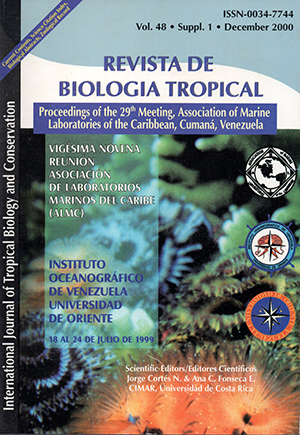Abstract
This paper is the second part of a baseline study carried out in the coastal region near a marine service station located in Morrocoy National Park, Venezuela. Results from a physical and chemical characterization of the water and sediments of four sites located around the service station are presented. The physical and chemical factors measured in water included: temperature, salinity, specific conductance, dissolved oxygen, saturation percentage of dissolved oxygen, pH, total suspended solids, transparency, oil and grease, total residual petroleum hydrocarbon, vanadium and lead, total coliform bacteria, and the presence of coliform bacteria. The factors measured in sediments include: granulometry, organic material, total carbonates, vanadium, lead, oil and grease, and total hydrocarbons. In addition, the amount of vanadium and lead in sample tissue from three species which are abundant and widely distributed in each site was measured in order to evaluate the potential of these species as bio-indicators. The water in the area where this study was conducted is shallow, warm, and thermally homogeneous, with high salinity and normal pH and dissolved oxygen, and supersaturated with oxygen in certain hours in sites adjacent to abundant underwater vegetation. The water is moderately turbid with a tendency towards less dissolved oxygen with increased depth. The estimated values of NMP/100 ml of the coliform fecal organisms is within legal limits even though the total number of water coliforms measured in Site 2 was ten times higher than in Site 1. This increase is associated with the proximity of Site 2 to an outflow of pre-treated sewage. The values of TRPH in the water collected from each site were low and very dose to the detection limit (O.5/ml). Vanadium was no! found, while lead was detected in 11 of the 12 samples. Compared to the values measured for Site 1, which was the local reference, only one sample had a concentration of three times the maximum baseline. The amount of lead found in all analyzed samples was acceptable, according to the standards set by the State of Washington (maximum value: 292 mg/kg), while the concentration of lead in the sediments around the supply dock were 1.5 to 3.4 times greater than the Dutch norm. It can be concluded that there is no evidence of an accumulation of Va or Pb in the species selected as bioindicators. An observation program is proposed in which variables similar to those measured for this characterization will be studied with some modifications. A more intense sampling of some variables is recommended (lead in water and sediments, total coliform and fecal matter in consecutive samples and in days following a high concentration of visitors) as is the elimination or minimization of other variables.Comments

This work is licensed under a Creative Commons Attribution 4.0 International License.
Copyright (c) 2000 Revista de Biología Tropical
Downloads
Download data is not yet available.


